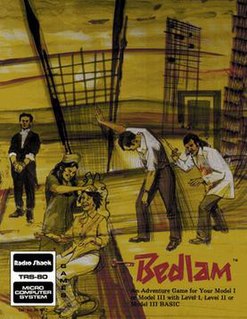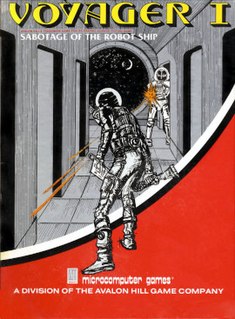Related Research Articles

The TRS-80 Micro Computer System is a desktop microcomputer launched in 1977 and sold by Tandy Corporation through their RadioShack stores. The name is an abbreviation of Tandy/RadioShack, Z80 microprocessor. It is one of the earliest mass-produced and mass-marketed retail home computers.

The RadioShack TRS-80 Color Computer is a line of home computers developed and sold by Tandy Corporation. Despite sharing a name with the earlier TRS-80, the Color Computer is a radical departure with its Motorola 6809E processor rather than a Zilog Z80. The Color Computer line is not compatible with software made for the earlier TRS-80.

RobotWar is a programming game written by Silas Warner. This game, along with the companion program RobotWrite, was originally developed in the TUTOR programming language on the PLATO system in the 1970s. Later the game was commercialized and adapted for the Apple II family of computers and published by Muse Software in 1981. The premise is that in the distant future of 2002, war was declared hazardous to human health, and now countries settled their differences in a battle arena full of combat robots. As the manual states, "The task set before you is: to program a robot, that no other robot can destroy!"
The Adventure Game Interpreter (AGI) is a game engine developed by Sierra On-Line. The company originally developed the engine for King's Quest (1984), an adventure game which Sierra and IBM wished to market in order to attract consumers to IBM's lower-cost home computer, the IBM PCjr.
Dung Beetles is an Apple II maze game by Bob Bishop published in 1982 by Datasoft. The gameplay is similar to Pac-Man, but a portion of the maze around the player-controlled character is enlarged as if being viewed through a square magnifying lens.

The EACA EG2000 Colour Genie was a computer produced by Hong Kong-based manufacturer EACA and introduced in Germany in August 1982. The company went bankrupt when its founder left it with a suitcase of money. TCS in Germany St, Augustin, near Bonn went bankrupt later. It followed their earlier Video Genie I and II computers and was released around the same time as the business-oriented Video Genie. The BASIC was compatible with the Video Genie I and II and the TRS-80, except for graphic and sound commands; most of the routines for Video Genie I BASIC commands were left over in the Colour Genie's BASIC ROM. Programs were provided to load TRS-80 programs into the Colour Genie. Colour Genie disks could be read in a TRS-80 floppy disk drive and vice versa, editing the pdrive commands.

Time Bandit is an action-adventure game written for the TRS-80 Model I by Bill Dunlevy and Harry Lafnear and published by MichTron in 1983. It was ported to the TRS-80 Color Computer and Dragon 32, but enjoyed its greatest popularity several years later as an early release for the Atari ST. It was also released for the pseudo-PC-compatible Sanyo MBC-55x with 8-color display. Amiga and MS-DOS versions were ported by Timothy Purves.

Dungeons of Daggorath is one of the first real-time, first-person perspective role-playing video games. It was produced by DynaMicro for the TRS-80 Color Computer in 1982. A sequel, Castle of Tharoggad, was released in 1988.

Microdeal was a British software company which operated during the 1980s and early 1990s from its base at Truro Road in the town of St Austell, Cornwall. The company, founded by John Symes was one of the major producers of games and other software for the 8-bit home computers of the time, in particular the Dragon 32 and the similar Tandy TRS-80 Color Computer ("CoCo").
Atom is an action game published by Tandy in 1983 for the TRS-80 Color Computer. The game educates the player about the elements of the periodic table from hydrogen through xenon.
SoftSide is a defunct computer magazine, begun in October 1978 by Roger Robitaille and published by SoftSide Publications of Milford, New Hampshire.
Spectral Associates was an American maker of computer games for the TRS-80 Color Computer. It was founded in 1980 and was defunct as sometime in the late 1980s. Spectral Associates sold their software through Radio Shack and via direct sales. It was a very prolific game company for the TRS-80 Color Computer I and II in its heyday.

Rear Guard is a horizontally scrolling shooter written for the Atari 8-bit family and released in December 1981 by Adventure International. Neil Larimer created the game with assistance from Sparky Starks. It was ported to the Apple II, TRS-80, and TRS-80 Color Computer.

Home computers were a class of microcomputers that entered the market in 1977 and became common during the 1980s. They were marketed to consumers as affordable and accessible computers that, for the first time, were intended for the use of a single nontechnical user. These computers were a distinct market segment that typically cost much less than business, scientific or engineering-oriented computers of the time such as those running CP/M or the IBM PC, and were generally less powerful in terms of memory and expandability. However, a home computer often had better graphics and sound than contemporary business computers. Their most common uses were playing video games, but they were also regularly used for word processing, doing homework, and programming.

Bedlam is a TRS-80 based text adventure game written for the TRS-80 by Robert Arnstein and released by Tandy Corporation in 1982. It was ported to the TRS-80 Color Computer. The object of the game is to escape a lunatic asylum. There are several ways to escape but only one random exit is active each time the game is loaded.

Scarfman is a clone of Pac-Man written by Philip A. Oliver for the TRS-80 computer and published by The Cornsoft Group in 1981. A version for the TRS-80 Color Computer followed in 1982 as Color Scarfman, which uses 64x64 low resolution graphics.

Voyager I: Sabotage of the Robot Ship is a computer game designed and programmed by William D. Volk, and published by the Microcomputer Games division of Avalon Hill. It was originally released for the Apple II in 1981, with later versions for the Atari 8-bit family, TRS-80 Color Computer, TRS-80, and Commodore PET.
The Sands of Egypt is an adventure game written by James Garon, Ralph Burris, and Steve Bjork of Datasoft for the TRS-80 Color Computer. It was licensed to Tandy Corporation and was the first disk-only game for the Color Computer sold by RadioShack. Ports to the Atari 8-bit family in 1982 and Apple II in 1983 were published by Datasoft. Set in 1893, the game follows a British explorer and archaeologist who is lost in the desert. Text commands are entered in the lower half of the screen, while a sometimes animated image of the current location is displayed in the upper half.
References
- 1 2 3 Boyle, L. Curtis. "Color Robot Battle". Tandy Color Computer Games.
- ↑ Hoffman, Paul "Robots Maneuver Humans Into Programming", The Rainbow (Apr 1983) Page 140-142.
- ↑ Color Robot Battle on the Programming Games Wiki